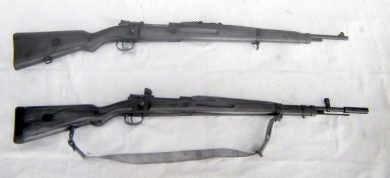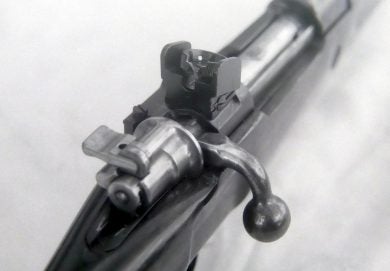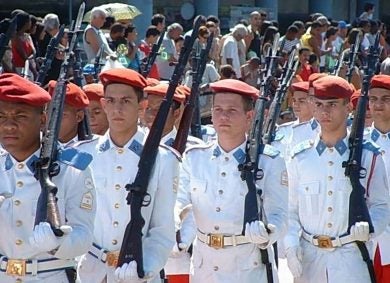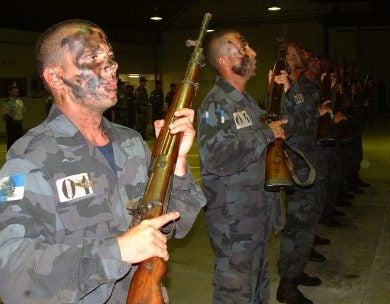Pretty much like many of the world’s countries in the early 20th Century, Brazil was a faithful user of German bolt-action Mauser rifles, to which the Spanish-favored 7x57mm round was chosen. The first adopted species was the Model 1894, soon followed by the Model 1904 rifle and the Model 1907 cavalry carbine, among other variants. The major type in large-scale use, however, was the DWM-made Model 1908 (actually, the Mauser 1898), examples of which were also assembled by Brazilian Army’s Arsenal de Guerra do Rio de Janeiro (Rio de Janeiro War Arsenal) with German-supplied parts. The rifle was officially designated Fuzil Ordinário 08 (Ordinary Rifle), but very generally called just the “F.O.” by everybody. Other Mauser-based carbine variants were also purchased from Czechoslovakia (CZ) and Belgium (FN) in the 1920s.

The “Fuzil Ordinário 08”, a.k.a. M1908, was the most widely used 7x57mm Mauser rifle of the Brazilian Armed Forces.
The WWII participation of a Brazilian Expeditionary Force in the Italian Front alongside the U.S. 5Th Army in 1944-45 witnessed the widespread use of American rifles (M1903 Springfield and M1 Garand) in combat, whose .30-06 ammunition was widely made available in the post-war years, this resulting in the official local adoption of that round in the 1950s. As an obvious consequence, most Brazilian Mauser Mosquetões (Musketoons), as they were generally called, were converted to use the American cartridge. This was done by the Army’s Fábrica de Itajubá (Itajubá Factory), in Minas Gerais state, the consequential guns being designated Mq .30 M949 and M954.

A Mosquetão M949 in .30-06 caliber as made by Fábrica de Itajubá for the Brazilian Army. Bolt-action was based on the Mauser M1898.
Another major change in rifle caliber ammunition took place in the mid-1960s, when the Brazilian Army decided to adopt the FN FAL rifle (locally, the Fz 7,62 M964) in 7.62x51mm, license production of which was the responsibility of the Itajubá Factory. As the full Mauser-to-FAL transition process would certainly take some time to occur, the military decided to start a program to first standardize ammo supplies to both rifles while in simultaneous use, the bolt-action rifles being transformed accordingly. Studies were carried out jointly by two Army industrial centers, the Arsenal de Guerra General Câmara, in Rio Grande do Sul State, and the Fábrica de Itajubá, to find the best way to come out with an intermediary NATO-round rifle. Although some older 7x57mm M1908 and M1924 Mauser rifles were simply re-chambered to the newer ammo, the resulting Mosquetão Calibre 7,62mm Modelo 1968 (Mq 7,62 M968, for short) was mainly based on the .30-06 M954 model.

The resulting Mq 7,62 M968 produced at Fábrica de Itajubá incorporated features of three different European rifles, the Mauser, the HK G3, and the FAL.
The new rifle was soon nicknamed the “Mosquefal” (Mosquetão + FAL), a clear indication of its transitional status between the two service rifles. Production was all undertaken at the Itajubá Factory, somehow side-by-side with the brand-new FALs coming out of the same facilities, having apparently reached the 10,000 mark. As a result of the close dimensional similarities between the .30-06 and the 7.62x51mm cartridges, minimum or no changes were required in the bolt, receiver and firing mechanism areas, the five-round, clip-fed system being also maintained. External changes, however, were present, this including the adoption of HK G3A3 sights (five-position, 100-600m rotary rear drum, and front protected blade) and the very same FAL flash-hider/grenade launcher. Fitted with a 610mm barrel (muzzle velocity: 890 m/s), the Mq 7,62 M968 had an overall length of 1100m and weighed 3.95kg.

Comparative view of the Mq .30 M954 (top) and the Mq 7,62 M968.

Close-up view of the G3A3 rear sight (here, in the open notch 100m-position) as fitted to the “Mosquefal”. Note that it was given a studier base and protection ears.

The rifle’s business end incorporating the G3A3 protected front sight and the FAL flash hider/NATO 22mm grenade launcher.
Use of the Mq 7,62 M968 by the Brazilian Army was generally limited to second-line units, guard and ceremonial duties, in addition to a wide employment by the so-called Tiros de Guerra, small recruits training units in cities not possessing major Army facilities. It is still seen today in military parades and as a “carry gun” during the initial, tough training phases in some State Military Police special outfits.

In addition the standard “Mosquefal” (top), Fábrica de Itajubá also played around with a short carbine variation (center), and a “sports” model (bottom), both of which did not progress further than the prototype stage.

Detail of the proposed short carbine version with the G3A3 front sight fitted, but no FAL flash hider.

“Mosquefals” on parade (Independence Day, September 7, 2003) carried by members of Colégio Militar do Rio de Janeiro, an Army-run pre-college organization.

Rusty examples of the Mq 7,62 M968 in the hands of just-graduated members of Rio de Janeiro Military Police’s GAM – Grupamento Aeromóvel, the airmobile elite unit. They’re non-firing, carry-only guns to always add 4kg to the trainees’ body…
 Your Privacy Choices
Your Privacy Choices
